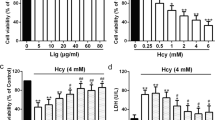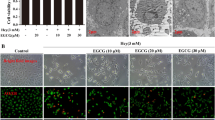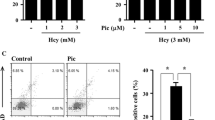Abstract
A relationship exists between hyperhomocysteinemia and cardiovascular diseases, although the underlying mechanisms are still incompletely defined. One possibility involves a homocysteine (Hcy)-induced increased oxidative stress. Melatonin (Mel) and vitamin E (vitE) are important anti-oxidants. The main purpose of this study was (1) to compare the effect of treatments with Mel, vitE or both, on Hcy-induced apoptosis in human umbilical vein endothelial cells (HUVECs), and (2) to investigate the underlying mechanisms. Cell proliferation assay was carried out by Water Soluble Tetrazolium-1 (WST-1) assay kit. Apoptotic index was calculated by TUNEL Assay. Anti-oxidant parameters were studied by measurement of reactive oxygen species (ROS) and lipid peroxidation (LPO) levels. mRNA and protein expression levels of apoptotic and anti-apoptotic genes and proteins were studied by quantitative real time polymerase chain reaction (qRT-PCR) and Western blotting experiments respectively. The results showed that treatments with Mel, vitE or Mel + vitE suppressed Hcy-induced cell death, with a higher efficiency for the Mel and Mel + vitE treatments. Our results suggests that the mechanisms by which these anti-oxidants protected endothelial cells include the decrease in ROS and LPO levels, an increase in cell migration, the downregulation of pro-apoptotic proteins Cas 3, Cas 9, Cyt C and Bax and the upregulation of anti-apoptotic protein Bcl 2. Collectively, these results revealed the protective role of vitE and Mel against Hcy-induced cell apoptosis, which may add insight into therapeutic approaches to Hcy-induced damages.





Similar content being viewed by others
References
Moretti R, Caruso P (2019) The controversial role of homocysteine in neurology: from labs to clinical practice. Int J Mol Sci 20(1):231
Rizzo A, Sciorsci RL (2019) Role of homocysteine metabolism in animal reproduction: a review. Res Vet Sci 122:29–35
Zhang Z et al (2017) Homocysteine induces apoptosis of human umbilical vein endothelial cells via mitochondrial dysfunction and endoplasmic reticulum stress. Oxid Med Cell Longev 2017:1–13
Balint B, Jepchumba VK, Guéant JL, Guéant-Rodriguez RM (2020) Mechanisms of homocysteine-induced damage to the endothelial, medial and adventitial layers of the arterial wall. Biochimie. https://doi.org/10.1016/j.biochi.2020.02.012
Li L, Hu BC, Gong SJ, Yan J (2011) Homocysteine-induced caspase-3 activation by endoplasmic reticulum stress in endothelial progenitor cells from patients with coronary heart disease and healthy donors. Biosci Biotechnol Biochem 75(7):1300–1305
Fang K, Chen Z, Liu M, Peng J, Wu P (2015) Apoptosis and calcification of vascular endothelial cell under hyperhomocysteinemia. Med Oncol 32(1):403
Darendelioglu E, Aykutoglu G, Tartik M, Baydas G (2016) Turkish propolis protects human endothelial cells in vitro from homocysteine-induced apoptosis. Acta Histochem 118(4):369–376
Tan DX, Manchester L, Esteban-Zubero E, Zhou Z, Reiter R (2015) Melatonin as a potent and inducible endogenous anti-oxidant: synthesis and metabolism. Molecules 20(10):18886–18906
Reiter RJ (2004) Mechanisms of cancer inhibition by melatonin. J Pineal Res 37:213–214
Shen YQ et al (2018) Combination of melatonin and rapamycin for head and neck cancer therapy: suppression of AKT/mTOR pathway activation, and activation of mitophagy and apoptosis via mitochondrial function regulation. J Pineal Res 64(3):e12461
Lowes DA, Webster NR, Murphy MP, Galley HF (2013) Anti-oxidants that protect mitochondria reduce interleukin-6 and oxidative stress, improve mitochondrial function, and reduce biochemical markers of organ dysfunction in a rat model of acute sepsis. Br J Anaesth 110:472–480
Cui P et al (2006) Effect and mechanism of melatonin action on the proliferation of human umbilical vein endothelial cells. J Pineal Res 41:358–362
Traber MG, Atkinson J (2007) Vitamin E, anti-oxidant and nothing more. Free Radic Biol Med 43(1):4–15
Niki E (2014) Role of vitamin E as a lipid-soluble peroxyl radical scavenger: in vitro and in vivo evidence. Free Radic Biol Med 66:3–12
Martin V, Sainz RM, Antolin I, Mayo JC, Herrera F, Rodriguez C (2002) Several antioxidant pathways are involved in astrocyte protection by melatonin. J Pineal Res 33:204–212
Hacışevki A, Baba B (2018) An overview of melatonin as an antioxidant molecule: a biochemical approach. Melatonin molecular biology, clinical and pharmaceutical approaches, pp 59–85
Do Ho et al (2015) δ-Tocopherol prevents methylglyoxal-induced apoptosis by reducing ROS generation and inhibiting apoptotic signaling cascades in human umbilical vein endothelial cells. Food Funct 6(5):1568–1577
Smith MT, Thor H, Hartzell P, Orrenius S (1982) The measurement of lipid peroxidation in isolated hepatocytes. Biochem Pharmacol 31(1):19–26
Shen HM, Shi CY, Shen YI, Ong CN (1996) Detection of elevated reactive oxygen species level in cultured rat hepatocytes treated with aflatoxin B1. Free Radic Biol Med 21(2):139–146
Chen YF et al (2018) Synergistic effect of HIF-1α and FoxO3a trigger cardiomyocyte apoptosis under hyperglycemic ischemia condition. J Cell Physiol 233(4):3660–3671
Tartik M, Darendelioglu E, Aykutoglu G, Baydas G (2016) Turkish propolis supresses MCF-7 cell death induced by homocysteine. Biomed Pharmacother 82:704–712
Tyagi N et al (2005) Mechanisms of homocysteine-induced oxidative stress. Am J Physiol-Heart Circ Physiol 289(6):H2649–H2656
Kumar D, Jugdutt BI (2003) Apoptosis, and oxidants in the heart. J Lab Clin Med 142:5–8
Vijayalaxmi TCR, Reiter RJ, Herman TS (2002) Melatonin: from basic research to cancer treatment clinics. J Clin Oncol 20:2575–2601
Chang CC et al (2018) Protective effect of melatonin against oxidative stress-induced apoptosis and enhanced autophagy in human retinal pigment epithelium cells. Oxid Med Cell Longev. https://doi.org/10.1155/2018/9015765
Paul R, Phukan BC, Thenmozhi AJ, Manivasagam T, Bhattacharya P, Borah A (2018) Melatonin protects against behavioral deficits, dopamine loss and oxidative stress in homocysteine model of Parkinson's disease. Life Sci 192:238–245
Hong JH et al (2004) Effects of vitamin E on oxidative stress and membrane fluidity in the brain of streptozotocin-induced diabetic rats. Clin Chim Acta 340:107–115
Zhai Y, Behera J, Tyagi SC, Tyagi N (2019) Hydrogen sulfide attenuates homocysteine-induced osteoblast dysfunction by inhibiting mitochondrial toxicity. J Cell Physiol 234(10):18602–18614
Tian X et al (2016) HSP27 inhibits homocysteine-induced endothelial apoptosis by modulation of ROS production and mitochondrial caspase-dependent apoptotic pathway. BioMed Res Int. https://doi.org/10.1155/2016/4847874
Baydas G, Reiter RJ, Akbulut M, Tuzcu M, Tamer S (2005) Melatonin inhibits neural apoptosis induced by homocysteine in hippocampus of rats via inhibition of cytochrome c translocation and caspase-3 activation and by regulating pro- and anti-apoptotic protein levels. Neuroscience 135:879–886
Baydas G, Canatan H, Turkoglu A (2002) Comparative analyses of the protective effects of melatonin and vitamin E on streptozotocin-induced diabetes mellitus. J Pineal Res 32:225–230
Celik S, Baydas G, Yilmaz O (2002) Influence of vitamin E on the levels of fatty acids and MDA in some tissues of diabetic rats. Cell Biochem Funct 20:67–71
Iwan P, Stepniak J, Karbownik-Lewinska M (2019) Melatonin reduces high levels of lipid peroxidation induced by potassium iodate in porcine thyroid. Int J Vitam Nutr Res. https://doi.org/10.1024/0300-9831/a000628
Osuna C et al (2002) Inhibitory effect of melatonin on homocysteine-induced lipid peroxidation in rat brain homogenates. Pharmacol Toxicol 90:32–37
Kim AD et al (2015) Esculetin induces death of human colon cancer cells via the reactive oxygen species-mediated mitochondrial apoptosis pathway. Environ Toxicol Pharmacol 39(2):982–989
Acehan D, Jiang X, Morgan DG, Heuser JE, Wang X, Akey CW (2002) Three-dimensional structure of the apoptosome: implications for assembly, procaspase-9 binding, and activation. Mol Cell 9(2):423–432
Chipuk J et al (2004) Direct activation of Bax by p53 mediates mitochondrial membrane permeabilization and apoptosis. Science 303(5660):1010–1014
Kroemer G, Dallaporta B, Resche-Rigon M (1998) The mitochondrial death/life regulator in apoptosis and necrosis. Annu Rev Physiol 60(1):619–642
Reed JC (1997) Double identity for proteins of the Bcl-2 family. Nature 387(6635):773
Kandeil MA, Hassanin KM, Mohammed ET, Safwat GM, Mohamed DS (2018) Wheat germ and vitamin E decrease BAX/BCL-2 ratio in rat kidney treated with gentamicin. Beni-Suef Univ J Basic Appl Sci 7(3):257–262
Pang YW et al (2019) Melatonin protects against paraquat-induced damage during in vitro maturation of bovine oocytes. J Pineal Res 66(1):e12532
Acknowledgements
This work was supported by a grant from Bingol University Independent Research Projects Office (BÜBAP), (Turkey). (Grant Number: BAP-261-278-2015). We would like to thank the directorate of Central Research Laboratory of the Bingol University for allowing us to use their laboratory facilities.
Author information
Authors and Affiliations
Contributions
ED, MT and GB conceived and designed research. GA, MT and ED conducted experiments. GA, ED, MT contributed new reagents or analytical tools. MT, AA, ED and GB analysed data. AA, MT, ED and GB wrote the manuscript. The authors read and approved the manuscript.
Corresponding author
Ethics declarations
Conflict of interest
The authors declare that there are no conflicts of interest.
Additional information
Publisher's Note
Springer Nature remains neutral with regard to jurisdictional claims in published maps and institutional affiliations.
Rights and permissions
About this article
Cite this article
Aykutoglu, G., Tartik, M., Darendelioglu, E. et al. Melatonin and vitamin E alleviate homocysteine‐induced oxidative injury and apoptosis in endothelial cells. Mol Biol Rep 47, 5285–5293 (2020). https://doi.org/10.1007/s11033-020-05607-z
Received:
Accepted:
Published:
Issue Date:
DOI: https://doi.org/10.1007/s11033-020-05607-z




